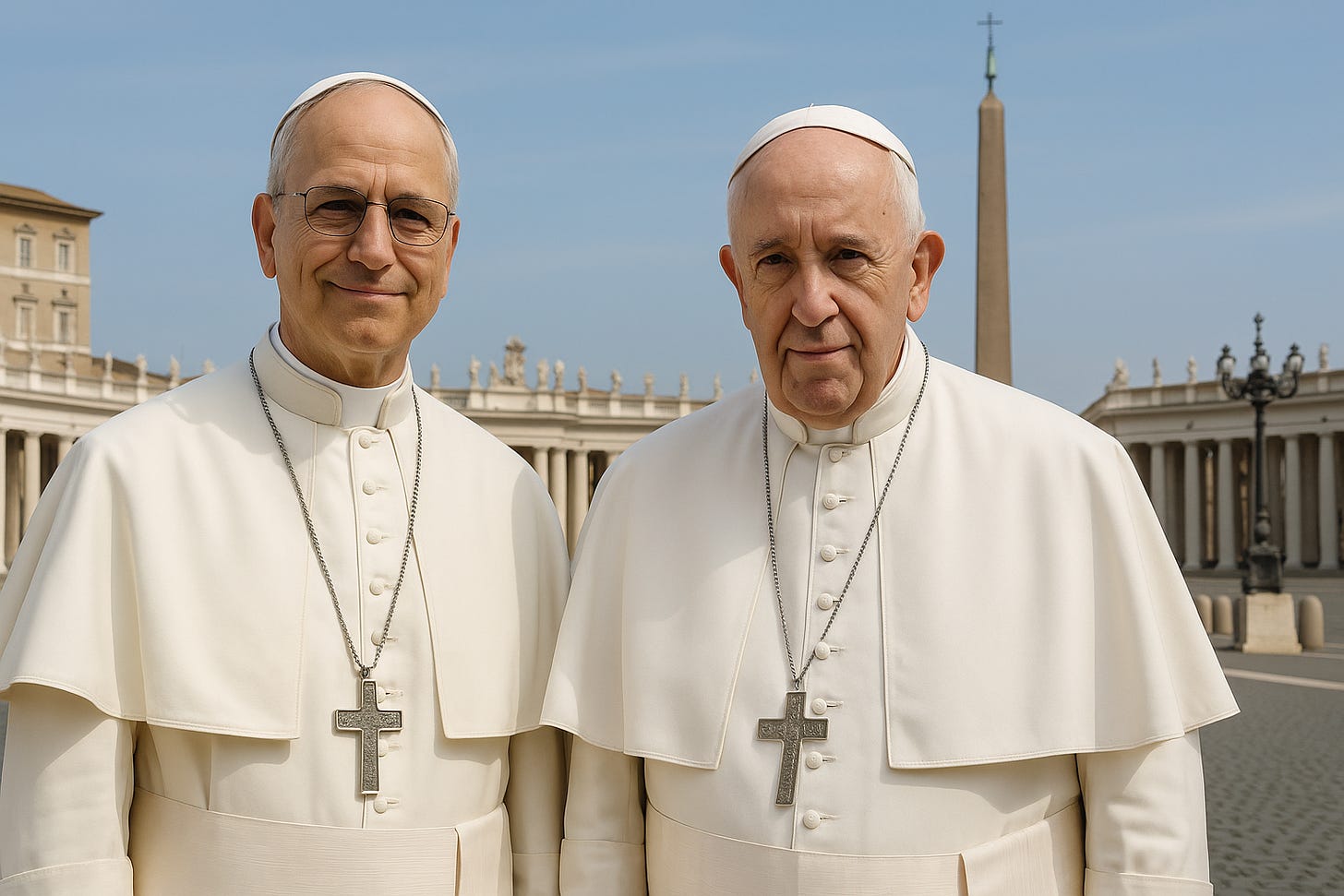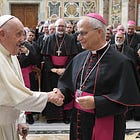'The Bishop of Rome': Francis' plan, continued by Leo XIV, for a grotesque parody of the papacy
The triumph of Anglicanism and Orthodoxy is nigh in the self-styled 'Conciliar/Synodal Church.'

The triumph of Anglicanism and Orthodoxy is nigh in the self-styled 'Conciliar/Synodal Church.'
'The Bishop of Rome': Francis' plan for a grotesque parody of the papacy
Matthew McCusker
A 2024 Vatican document reveals the roadmap by which Francis intends to establish a new “synodal papacy,” which will preside over a new “synodal church.”
This new “synodal papacy,” which is intended to replace the papacy permanently established by Christ, would lead a global ecumenical church without doctrine or discipline.
The new “working document,” called “The Bishop of Rome,” was drafted with input from Protestants and Orthodox. It outlines a number of objections to Catholic doctrine and presents suggestions of how the exercise of the papal office can be transformed.
These objections and suggestions have been drawn from submissions sent to the Vatican by non-Catholic denominations in response to John Paul II’s 1995 document Ut Unum Sint.
That the Vatican is revisiting these submissions 29 years after Ut Unum Sint was first issued should be a cause of alarm to everyone who is aware of the methods deployed by the Vatican under Francis.
Presenting heterodox ideas in non-authoritative documents, and then later attempting to make them “official” teachings, is a strategy that has been used many times during the last decade.
We have seen it used, for example, to pursue Holy Communion for the divorced and remarried and “blessings” for same-sex “couples.”
For this reason, this 150-page compilation of theological errors and radical suggestions for reform deserves more attention than it has hitherto received.
If we approach the document with the known methodology of the Vatican in mind, we come to a startling conclusion: that they intend to abolish the papacy – at least in the eyes of the world – and replace it with a new institution, which will serve as the head of an institution that the documents call “an authentic conciliar/synodal Church,” (No. 112) which is to be synodal “at every level” (Nos. 81-3).

This article sets out what would occur if the objections to Catholic doctrine and the suggestions for reform made in this non-authoritative document were to be accepted and implemented – in the same way as Holy Communion for the divorced and remarried, and same-sex “blessings” have been before them.
Stage I. The redefinition of the Catholic understanding of the papacy
The first stage would be to undermine the scriptural and theological foundations of the papacy, and to replace Catholic doctrine with “a renewed understanding and exercise of the Petrine ministry” based on “synodality” to fulfil Francis’s vision of a “synodal Church.” (No. 5). This reform of the papacy would flow from the “commitment” of Francis to “build a synodal Church at all levels.” (No.5)
The document indicates they will carry this reinterpretation out as follows:
They will re-interpret Sacred Scripture so that it supports a “synodal” understanding of the papacy in which the pope is just a figurehead with no real authority (see Nos. 35 -39).
They will give new meanings to the concepts of “authority” and “service” so that the real authority of the papacy will be destroyed (see Nos. 40-42).
They will seek out ambiguous passages in the Church Fathers which could be deployed to provide a basis for a new understanding of the papacy (see Nos. 44-47).
They will reinterpret the infallible teaching of Vatican I on the divine institution of the papacy by means of a new “hermeneutic,” which will bring Catholic doctrine into line with the views of the Orthodox and the Protestants (see Nos. 48-56).
The same “hermeneutical approach” will be used to solve the “obstacle” of Vatican I’s infallible definitions of papal jurisdiction and papal infallibility. See (No. 57–73).
They will reinterpret Vatican I in light of (i) Vatican II (see Nos. 61, 66, 72), (ii) a reconstruction of the real “intentions” of the Council Fathers at Vatican I (see No. 62-63) and (iii) a “distinction between the text and its interpretation” which will allow them to interpret the text in a way that suits their agenda (see Nos. 64-66).
They will rehabilitate the previously condemned error that the exercise of infallibility requires the consent of the Church (see Nos. 72, 106).
Stage II. The establishment of the synodal papacy
Once the orthodox idea of the papacy has been discredited, the path will be open to establish the new “synodal papacy,” which will preside over a new inclusive church void of doctrine or discipline. All the baptized will be invited into this synodal church, without having to abandon their doctrinal errors.
The synodal papacy will have these characteristics:
It will have “a primacy of honor” only, with no real authority over Orthodox and Protestant believers who will be invited to come under its banner (see No. 76-80, 94-98).
It will preside over a church which is synodal “at every level” and will therefore no longer be subject to authority, or possess the unity of faith, worship and government which are essential marks of the Catholic Church (see Nos 81-83).
It will preside not by divine right, but simply because there is a “pragmatic argument” for “the need for a ministry of unity at the universal level” (see No. 62-68).
It will be based on the papacy of the “first millennium,” which will be considered the “decisive” model. Later definitions and developments of doctrine regarding the papacy will be ignored. (See Nos. 89-91, 99-100, 104-107).
It will shun the exercise of “juridical” authority (See Nos. 92-93).
It will replace the immediate and ordinary jurisdiction of the papacy with a mere right to appeal to the Roman See (see Nos. 101-103).
It will exercise its primacy over a new “authentic conciliar/synodal Church” (see No. 112).
The seven steps and seven characteristics outlined above are reasonable inferences from the content of the document.
There will of course be those who reject such an interpretation as an exaggeration or a misinterpretation of the text. These are likely the same people who said there was no danger of Francis ever allowing Holy Communion for the divorced and remarried, or ever permitting same-sex ‘blessings”.
But those who understand the true nature of the Conciliar/Synodal regime, ought to regard the of “The Bishop of Rome” as a warning of what may be to come.
… Continued by Leo XIV
S.D. Wright
Following the 2025 conclave, Leo XIV clearly endorsed this programme, and indicated his intention to follow in the trajectory it has marked out.
In his first Urbi et Orbi speech, he declared his desire to lead “a synodal Church, a Church that moves forward.”
In his address to the College of Cardinals, he pledged “complete commitment to the path that the universal Church has now followed for decades in the wake of the Second Vatican Council”—and emphasised a “growth in collegiality and synodality” as a central aspect of this path.
Leo’s inaugural homily (18 May) caricatured the ordinary exercise of papal authority as “autocracy” and “lording it over” others, and recast the Roman Pontiff as one who “walks alongside” the faithful. Prevost had made similar comments as Prefect of the Dicastery of Bishops.
His language in the inauguration homily closely echoes the modernist vision condemned by Pope St. Pius X.
Speaking at an audience of representatives of other religions (19 May), he said:
Aware, moreover, that synodality and ecumenism are closely linked, I would like to assure you of my intention to continue Pope Francis’ commitment to promoting the synodal nature of the Catholic Church and developing new and concrete forms for an ever stronger synodality in ecumenical relations.
By contrast, Vatican I teaches:
[I]f anyone says that blessed Peter the apostle was not appointed by Christ the lord as prince of all the apostles and visible head of the whole church militant; or that it was a primacy of honour only and not one of true and proper jurisdiction that he directly and immediately received from our lord Jesus Christ himself: let him be anathema.
One of Leo’s first meetings since the conclave was with Cardinal Kurt Koch, the Vatican’s leading ecumenist and grand architect of ‘The Bishop of Rome’ document—and thus the “synodal papacy.” This audience places Koch in early and direct contact with the newly elected “Synodal Pope.” It adds to already overwhelming evidence of Leo XIV’s alignment with the synodal trajectory inaugurated under Francis.
As Fr David Nix (Padre Peregrino) commented on this very topic:
[I]n his opening speech from the loggia in 2025, Leo declared himself to be the pope of the “synodal church.”
I believe him.
HELP KEEP THE WM REVIEW ONLINE WITH WM+!
As we expand The WM Review we would like to keep providing free articles for everyone.
Our work takes a lot of time and effort to produce. If you have benefitted from it please do consider supporting us financially.
A subscription gets you access to our exclusive WM+ material, and helps ensure that we can keep writing and sharing free material for all.
(We make our WM+ material freely available to clergy, priests and seminarians upon request. Please subscribe and reply to the email if this applies to you.)
Subscribe to WM+ now to make sure you always receive our material. Thank you!
Read Next:
Follow on Twitter, YouTube and Telegram:








The ironic aspect of this new Conciliar/Synodial/listening Church, is that all of these changes in doctrine, sacraments and discipline were implemented against the will and desire of the overwhelming majority of Catholics, by a small group of determined heretics that would/will not let anything stand in their way.
Bergoglio, Prevost, and all the heretics in the ape of the church can call it whatever they want, synodal or otherwise. It does not change the FACT that is it HERESY which means they have all excommunicated themselves by the pertinacious profession of heresy.